See edit at the bottom of the article with the runner’s response and click the link for an update.
Follow Up Article
Eddie claims 25 Ironman finishes and 40 marathons. He competed in The Ironman World Championships in Kona in 2013. Indeed, looking back he appears to be (or been) a very strong athlete. He has many sub 3:30:00 marathons that appear to be completely legitimate. However, his result at the 2017 Phoenix Marathon raised at least one person’s suspicion and led to him being reported to me about just prior to the 2018 Boston Marathon.
Eddie qualified for the 2018 Boston Marathon at The 2017 Phoenix Marathon. He also posted a Boston qualifying time at Phoenix in 2018 which would qualify him for entry into The 2019 Boston 2019 Boston Marathon.
Phoenix is a point to point downhill course.


There are published splits at the 1/2 Marathon, and the 20 mile mark.
2017 Phoenix Marathon Result – 3:11:46
- Eddie hit the 1/2 split in a time of 1:30:08, a pace of 6:53 per mile. He finished in a time of 3:11:46. He ran the 2nd half in 1:41:38, a pace of 7:45 per mile. His overall pace was 7:19 per mile. He missed the 20 mile checkpoint.
Given the elevation profile, the pace for this race doesn’t raise flags on its own. There are other details that do raise some flags:
- He missed the 20 mile checkpoint.
- 10 minute gun/chip differential (note: there were handful others with larger differentials)
- Personal Record (This is a PR type course) – but he has run it multiple times and was a much faster runner in prior years and never approached this time. This time is a significant improvement over his prior available Phoenix times.
2018 Phoenix Marathon Result – 3:18:28
This time Eddie hit all the splits. He ran the first half in 1:28:01, a pace of 6:43 per mile. He ran the 2nd half in 1:50:28, a pace of 8:26 per mile.
- Fast first half – faster than any found legitimate split time at any other race. Faster than his first half splits in Phoenix from 2015 and 2016. Splits are not available prior to 2015
- 2015 – 1:40:34 1st half
- 2016 – 1:39:24 1st half
- 2017 – 1:30:08 1st half
- 2018 – 1:28:01 1st half
- 10 minute gun/chip differential for the 2nd consecutive year. Starting at the back of the pack is not a typical strategy when trying to run a BQ and certainly would not be conducive to his fast 1st half time.
The 10 minute start differential was not repeated at Eddie’s other Phoenix Marathon finishes.
When I first learned about Eddie, I was suspicious. But it was 1 week before Boston, and nothing I could do at that point would make a difference in his running Boston in 2018. It was only later that I began to dig deeper.
Phoenix Marathon Times
2013 3:49:35
2014 3:43:41
2015 3:25:18 (BQ – but not by enough to get him into Boston)
2016 3:41:19
2017 3:11:46
2018 3:18:28
After coming close to getting into Boston in 2015, he ran a much slower time in 2016 before qualifying in 2017 and 2018. His Phoenix times improved significantly from 2013 to 2018. He has run quite a few races over this time period. Do the rest of his races follow this trend?
| Date | Time | Marathon |
| 2/7/2013 | 3:46:37 | Lost Dutchman |
| 3/2/2013 | 3:49:35 | Phoenix |
| 2/16/2014 | 3:41:53 | Lost Dutchman |
| 3/1/2014 | 3:43:29 | Phoenix |
| 1/8/2015 | 3:29:15 | RNR Arizona |
| 2/28/2015 | 3:24:18 | Phoenix |
| 5/3/2015 | 3:44:56 | Colorado Marathon |
| 9/5/2015 | 3:42:12 | Pocatello |
| 10/4/2015 | 3:25:41 | Portland |
| 12/6/2015 | 3:38:23 | Tucson |
| 2/14/2016 | 3:59:28 | Lost Duchman |
| 2/27/2016 | 3:41:19 | Phoenix |
| 6/5/2016 | 3:34:06 | RNR San Diego* |
| 10/9/2016 | 3:45:40 | Portland |
| 2/25/2017 | 3:11:46 | Phoenix* |
| 4/30/2017 | 5:23:13 | Big Sur |
| 6/4/2017 | 4:29:02 | RNR San Diego |
| 2/24/2018 | 3:18:28 | Phoenix* |
| 4/16/2018 | 4:48:38 | Boston |
| 6/3/2018 | 3:52:57 | RNR San Diego* |
Eddie’s times were getting gradually slower 2014 to 2018. The real exceptions being Phoenix Marathon and RnR San Diego Marathon. The smoking guns were found in the San Diego results.
2016 Rock n Roll San Diego Marathon
On his way to a time of 3:34:06, he covered the distance between 13.1 and 20 in a time of 20:25, a pace of 2:58 per mile. The course map illustrates the opportunity to cut the course.
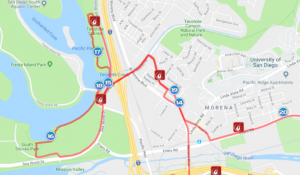
2018 Rock n Roll San Diego Marathon
| Split | Total Time | Overall Pace | Split Pace |
| 6.2 | 1:00:35 | 0:09:46 | 0:09:46 |
| 13.1 | 2:01:18 | 0:09:16 | 0:08:48 |
| 20 | 2:45:25 | 0:08:16 | 0:06:24 |
| 26.2 | 3:52:57 | 0:08:53 | 0:10:54 |
Once again, his pace increased significantly between the 1/2 marathon and 20 mile checkpoints. I have also confirmed that he missed an unpublished timing mat. The change in pace has resulted in him being disqualified.
Interestingly he was an official 4 hour pacer for the race. I reached out to the running club that supplied the pacers. They confirmed his status for the race and offered the following in way of an explanation:
Yes he was an official pace setter. I was told that he had to pull off at some point to use a bathroom and then rejoined the group, bringing them in under his 4:00 obligation.
The initial explanation was vague on how they claim that he rejoined the group. But the following response was offered up as a potential justification.
There are those that handle the pacers that think, quite frankly, that this should be a none issue due in large part because the pacers are just there to assist runners with their respective goal finishing time and are not to concerned whether Eddie cut the course or not.
My stance on this should be obvious. You should only take a finisher medal and claim an official time if you actually ran the entire course. However, I felt obligated to investigate the circumstances the best I could with the available race data in order to answer those that felt this instance of course cutting may be justified.

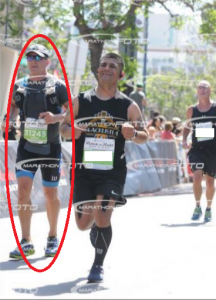
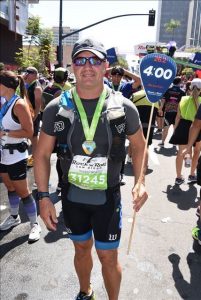
He was carrying the pacer sign pre-race as shown in the first photo. The 2nd photo shows that he was not carrying the stick at the finish. He then appeared to wait for the 4:00:00 pace group to cross the line and posed for a photo with the sign.
I Have been unable to confirm who provided this information to the club, but it is inaccurate.
- I have downloaded the entire marathon results, and was able to determine Eddie’s actual start time of day. This is confirmed as it matches another runner that was pictured with him at the start. Eddie and this other runner started 12:17 and 12:18 after the gun.
- Had Eddie picked up the group at some point and brought them in under his time obligation, I should have been able to see evidence of that in the data. Eddie’s clock time was 4:05:14. There is no one within a minute ahead or behind Eddie’s finish time that started close to the same time as Eddie. The photos also indicate that he wasn’t ‘pulling anyone in’ I checked all runners that finished near him. No evidence of the pace group or the 4:00:00 stick until after the finish where he apparently waited for the group to cross and got himself in a photo with the stick.
- Assuming the 3:55:00 pace group was not well ahead of target, he would have passed them. That seems very unlikely that a pacer would pass another pace group while ahead of schedule.
At some point he turned his official pacer shirt inside out. I have learned that this is often protocol for when a pacer falls behind pace so that other runners don’t think they are on track for that time. As shown in the data, Eddie fell behind pace almost immediately and was still behind pace at the half marathon point. So, by itself the fact that he flipped his shirt is not suspicious. One could theorize on other possible motivations, but that would just be speculation.
To summarize, the explanation provided does not agree with the evidence. The potential justification is moot.
EDIT: Attached is Ed’s response to the article. His account is different than I received from the running club that was in charge of the pacers. I will address a couple of his other comments regarding the missed mat in Phoenix and his practice of starting in the back.
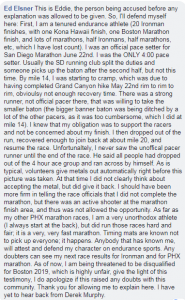
Thank you to all those that support the site. Contributions help cover costs associated with running MarathonInvestigation.com. If you support what we are doing, please consider a small contribution.
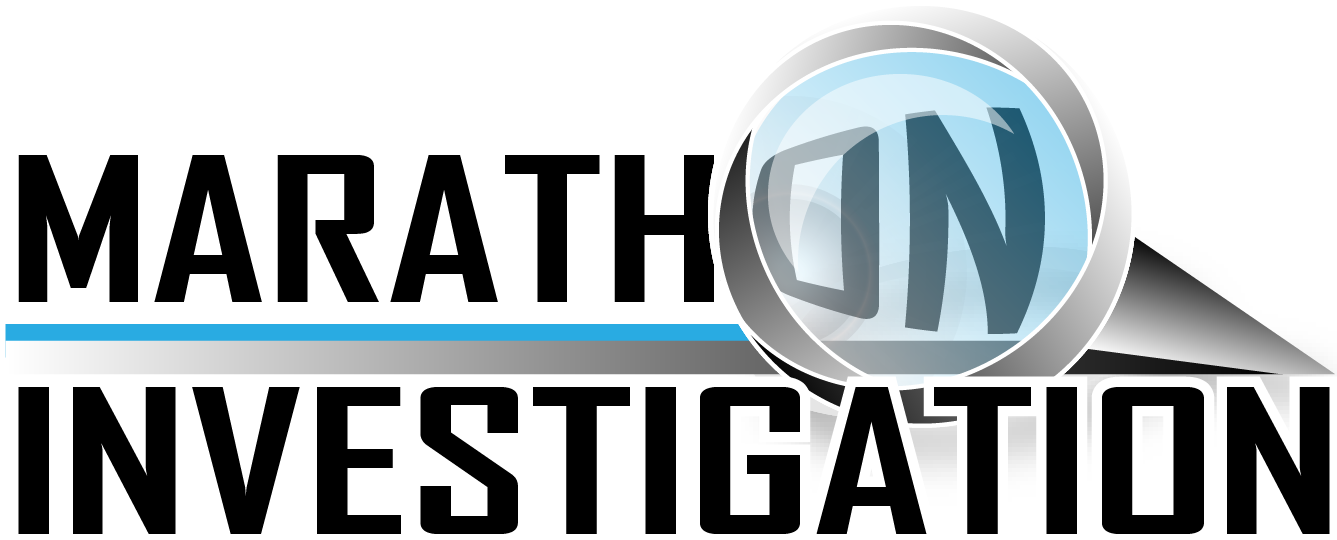
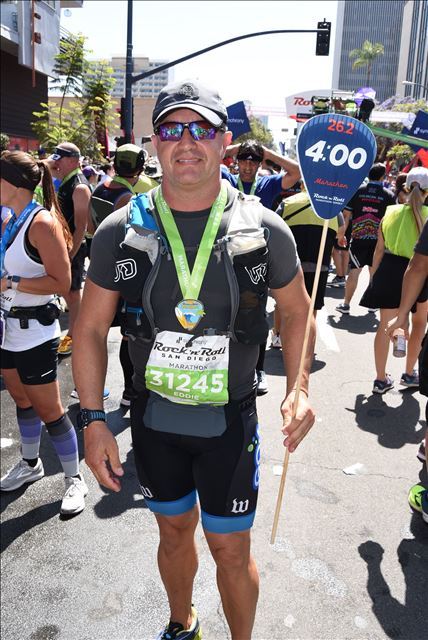
DOUBLE LETTERS!
R2R2R “hike” (his word) is no picnic, but a “tenured endurance athlete” (his words) of his supposed caliber should be fully recovered after a full month. Look at his last three of 2015, and first two of 2016. Seems to be pretty good recovery there. (BTW, that 3:25 in Portland is rather suspicious; all the recent Portland certification maps show numerous places to cut the course. I’ve heard some stories about THAT one.)
I have done that hike in under 11 hours. It isn’t that hard. For real. I mean, heck, I met people who were running it Rim-to-Rim-to-Rim that day.
Not meaning to question you, Goodness, but are you sure you went fully South to North and back to South? (Or the opposite)? I have ultramarathon friends that run R2R2R with a small burrito and a bottle of water in their hand. It takes them 14-16 hours to run it, almost without stopping. I would find it hard to believe you can “hike” 44 miles in 11 hours with that elevation gain. But I’m not saying I could do better. It took me two days. I have many tougher friends than I, and I doubt any of them would say “it isn’t that hard.”
I agree that 1 month is more than enough time to recover, unless you suffered a specific injury. You would not have “cramping” a month later due to R2R2R.
As a masters marathoner who both races marathons and paces marathons, I can tell you I can race a marathon and the next weekend pace a marathon 20-30 minutes slower than my normal racing pace, just fine. I do this all the time as do other marathon pro-pacers I know. As a pacer, you should never pace a race where it would even be a moderate effort; it should be an “easy” pace for that pacer, otherwise falling behind will happen (of course yeah sometimes a pacer is just not feeling well/sick but that’s the rarity).
Sounds to me like this guy is a regular 4:30-5 hour marathon finisher and therefore his 4 hour pacing duty is way out of league and that the pacing club probably thought he could handle it based on previous (cheating?) finish times. Eddie then thinks he can do the 4 hour pace job by cutting the course like he did when he “raced”.
Also, Portland has a few out-&-backs. Again, an easy way to cut the course. There is one really long out-&-back stretch where one could cut and knock off some serious time. And near the end, there is a loop that goes around the block. A runner could not do that loop and just cut over the street toward the finish.
And like I’ve told Derek, I have witnessed several people cut RnRs, and some looked like they were in my division, and potentially stealing my podium place. This is why I don’t care for RnR courses. Just a bunch of out and backs.
Looks like he is being active on the FB page, has anyone asked for the garmin file? Looks like he wears a Garmin 920XT on a lot of this race pictures or is the file “missing” for 2017/2018?
Weird. I ran the same Big Sur race. I think you have his results transposed. Results book reads 5:32:31 not 5:23:13. Anyway. I ran 4:56 that day after a 2015 marathon debut at 4:20.
Conditions in Big Sur were beautiful, albeit just a little warmer than usual, and there were low/no winds (which the race is infamous for). It’s always a tough course but unless he was injured that was a long time for that day – esp. given his many sub-4 hour races. Of course Big Sur is a straight course and there’s no way to get off and get back on – the mountains and Pacific make sure of that.
Looks kinda like the same guy with some added pounds. Hard to say definitively: https://www.marathonfoto.com/Proofs?LastName=ELLIS&PIN=W19600. Again the Eisner>>>Ellis thing is weird and Ellis is the only person with a weird transposed time. No one in the 2017 Results book has a time of 5:23:13. So Ellis with 5:32:31 must be him. (I see why Derek does this – it’s a mystery to unravel).
How does Mr. Ed explain away the BQ qualifiers in 2017 and 2018? Mat problems over and over? This is not missed mat problem. The time differential simply doesn’t add up. Also, how did the 4 hr pace stick pop back out at the finish? Why did he have a need to take a photo with it?
I just don’t understand how you cross a finish line and take a medal if you didn’t legitimately run the race, especially if you’re supposedly such an experienced athlete.
Now maybe all of us have made one bad decision, and he’s now owned up to this one. I could almost now say the the rest of Derek’s arguments are a bit circumstantial. Except that 2016 San Diego RNR is an issue.
Plus it’s always the folks with suspect times who miss the mat times. I just looked at my 2017 marathon results. Their were 7 interim mats (not counting start/finish). For the 1295 people who finished in under 5 hours, the successful mat recording rate was 98.93%. Wow, these folks with the suspicious times are so unlucky.
It’s funny while I was digging through the Big Sur results (see above) I noted I missed the mat at 17 miles. I don’t know how, but I most certainly did. I do remember running on the yellow line quite a bit just because that’s where the road camber was least. That’s probably how it happened. But I’ve done 23 races, of all types, in the last 3 years and that’s the first mat I missed.
How did this cheat Kona qualify?
Legacy Lottery. http://www.ironman.com/triathlon-news/articles/2013/04/2013-lottery-and-legacy-winners.aspx#axzz5PPJDAT7g
Rules with current dates:
Athlete must have completed a minimum of 12 full-distance IRONMAN-branded* races (includes existing and past events) by December 31, 2017.
Athlete has never participated in the IRONMAN World Championship in Kailua-Kona, Hawai’i.
Athlete must have completed at least one full-distance IRONMAN event in both 2016 and 2017.
Athlete must be registered for a full-distance IRONMAN event in 2018.
Originally from: http://www.ironman.com/triathlon/events/americas/ironman/world-championship/register/ironman-legacy-program.aspx#ixzz5PUvFZO99